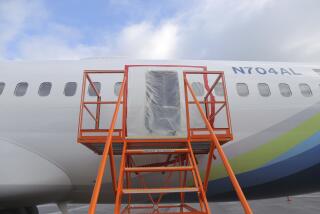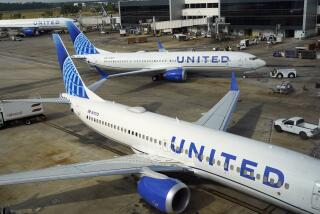Manipulated Power to Engines : JAL Pilot Fought Disaster to the End, Tape Shows
- Share via
TOKYO — With pieces of the Boeing 747’s tail section tearing away and with hydraulic controls seemingly gone, Japan Air Lines Capt. Masami Takahama desperately tried to nurse his wildly bucking aircraft to a safe landing by manipulating power to its four engines, according to a transcript and analysis made public Monday.
But even the 49-year-old pilot’s special skill in this technique proved insufficient to the task, and after more than half an hour of terrified airborne wandering through the skies over the Japanese countryside, Japan Air Lines Flight 123 plowed into a mountain ridge about 70 miles northwest of Tokyo as dusk set in on Aug. 12.
Among the 524 people aboard, only four passengers survived history’s worst single-aircraft disaster.
While the cause--and much that occurred during the plane’s final minutes--have yet to be determined, fragments of conversation from its voice recorder show that Takahama and co-pilot Yutaka Sasaki, 39, tried to control the doomed jumbo jet until the very end.
Japanese press reports Monday quoting a preliminary Transport Ministry analysis of the tape, and quoting from a transcript of conversations between the cockpit and ground controllers, showed that about 6:35 p.m.--10 minutes after Capt. Takahama declared an emergency--a crew member said, “Hydraulic (systems) are all out.”
A voice, probably the pilot’s, followed with a series of orders--including “Turn right,” “Increase power” and other instructions.
None of the orders was to prove effective.
Takahama, who was married and the father of two children, was an experienced pilot, having logged 12,404 flight hours, including 4,588 in 747s, according to JAL’s senior jumbo-jet pilot, Capt. Yoshio Iwao. “He was one of our best pilots,” Iwao said.
Iwao, who doubles as manager of JAL’s 747 Flight Crew Department, said Takahama had served as an instructor on the aircraft for the last three years and was an expert in the “very difficult” technique of flying the huge aircraft by using only increased or reduced throttle power to the engines.
The supervising officer added that altitude changes on radar plottings suggested that the pilot had gradually lost control over elevators situated on the horizontal tailpiece, devices that are used to climb or descend.
Notes Before Dying
As Capt. Takahama and his cockpit crew sought futilely to right the course of the aberrant aircraft, individual stories of terror, pathos and great personal courage unfolded in the passenger cabin.
In one striking case minutes before the crash, passenger Hirotsugu Kawaguchi dashed notes across seven pages of a pocket calendar--describing his thoughts as he was about to die, his family said.
“Be good to each other and work hard. Help your mother,” wrote Kawaguchi, 52, as many of his fellow passengers scrambled for oxygen masks and life vests.
“I’m very sad, but I’m sure I won’t make it. I don’t know the reason,” he said in messages addressed to his wife, Keiko, 51; his daughters Mariko, 24, and Chiyoko, 17, and his son, Tsuyoshi, 21.
Then, noting that five minutes had passed since the plane had gone out of control, he continued: “I don’t want to take any more planes. Please Lord, help me.”
He added: “To think that our dinner last night was the last time.”
In a description of his surroundings, which investigators called valuable evidence, he wrote: “There was smoke that seemed to come from an explosion in the cabin and we began making a descent. What will happen from here?” he asked.
“Tsuyoshi, I’m counting on you,” he wrote to his son.
“Mother, to think something like this would happen,” he penned to his wife. “It’s too bad. Goodby. Please take good care of the children.
“It’s 6:30 now,” he noted.
At about that time, the pilot was messaging he was unable to control the plane, according to Transport Ministry records.
Two other victims also put down last-minute thoughts. Kazuo Yoshimura, 41, an architect, wrote, “I want you to be strong” on the back of a company document, said his family, who reported finding the bloodstained paper among his belongings.
A 40-year-old businessman wrote on an air-sickness bag to his wife, “Osaka (his home prefecture), Mino (his home city), Machiko, please take care of my children. Masakazu Taniguchi. 6:30.” The man’s wallet and driver’s license were found in the bag.
Radio and radar transcripts released by the Transport Ministry show that at 6:25 p.m., about 30 minutes before the crash, Takahama told Tokyo air controllers he was declaring an emergency and descending from 24,000 feet to 22,000 feet. However, radar readings indicated that the plane instead climbed to 24,900 feet in the next two minutes.
“That shows he had difficulty with the elevators, which aren’t known to have blown away,” Iwao said. “It only could point to extensive damage to the hydraulic system.”
The pilot, he went on, would normally reduce power in all four engines to make a gradual descent. Radar records show that it took 15 minutes for the plane to descend to 11,900 feet from 24,900 feet.
With his direction controls gone, Takahama probably cut power to his starboard engines to turn east toward Tokyo, Iwao said, which could account for the aircraft’s wide curve near Mt. Fuji, 62 miles west of Tokyo. Over-manipulation of power, with no stabilizing tail fin, could explain a complete circle minutes later. As far as is known, Takahama did not know that his rudder and most of the tail fin were gone.
Witnesses who saw JAL Flight 123 in its final moments said it was flying “very low,” and one last saw it ascending--northbound--along the slope of 6,032-foot Mt. Mikuni.
Unable to climb normally, Takahama would have used full throttle to all engines to clear the mountains. After skimming several ridges, the plane clipped through trees on one and then smashed into 5,408-foot Mt. Osutaka.
Meanwhile, technical specialists of the Boeing Co. were reported Monday to have discounted the theory that the collapse of a cabin pressure bulkhead caused the disaster.
An airline source, asking not to be identified by name, said five Boeing experts had expressed strong doubt about the bulkhead theory after a visit to the mountaintop crash site Thursday--along with four U.S. government aviation experts and Japanese officials.
“The Boeing people said there was nothing to indicate that the damage to the bulkhead was due to anything but the crash itself,” the airline source said. “We know that is what they have told the Japanese.”
And JAL’s own chief 747 technician, Hiroaki Kohno, told a news conference that yet another theory of the cause of the crash is being studied--that the plane’s vertical tail fin was initially damaged by “external pressure” rather than from a sudden rush of pressurized air from inside the plane.
He did not say what might have struck the tail fin from the outside hard enough to cause it to break apart. Officials originally suspected it had been hit by a flying door, but the door was found in the wreckage, still intact.
In a related matter, an expert on the 747 for Pan American World Airways said in New York on Monday that the JAL aircraft was so outfitted as to be capable of gliding without engines and was equipped with a vast array of backup systems that helped keep it aloft on its long, eventually doomed flight.
“Everything is redundant (duplicated),” said James Arey, system director for the airline that reportedly operates the world’s largest 747 fleet and that helped finance the jumbo jet’s initial development.
“Take the inertial navigation system,” Arey said. “There are three systems. The first one drives the plane. The second--System No. 2--checks System No. 1, and System No. 3 checks to make sure System No. 2 is checking System No. 1. All that takes place while System No. 1 is monitoring No. 3 to make sure it is doing its job.
“It’s an incredible system of checks and balances, lights, bells and whistles.”
More to Read
Sign up for Essential California
The most important California stories and recommendations in your inbox every morning.
You may occasionally receive promotional content from the Los Angeles Times.










